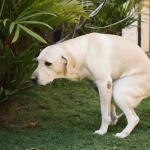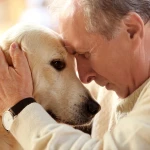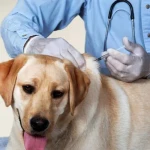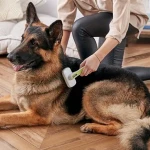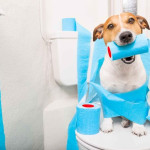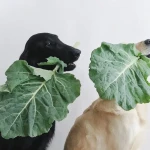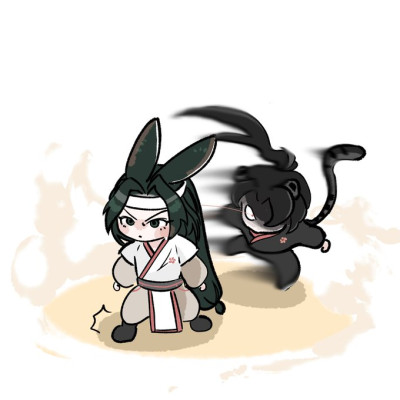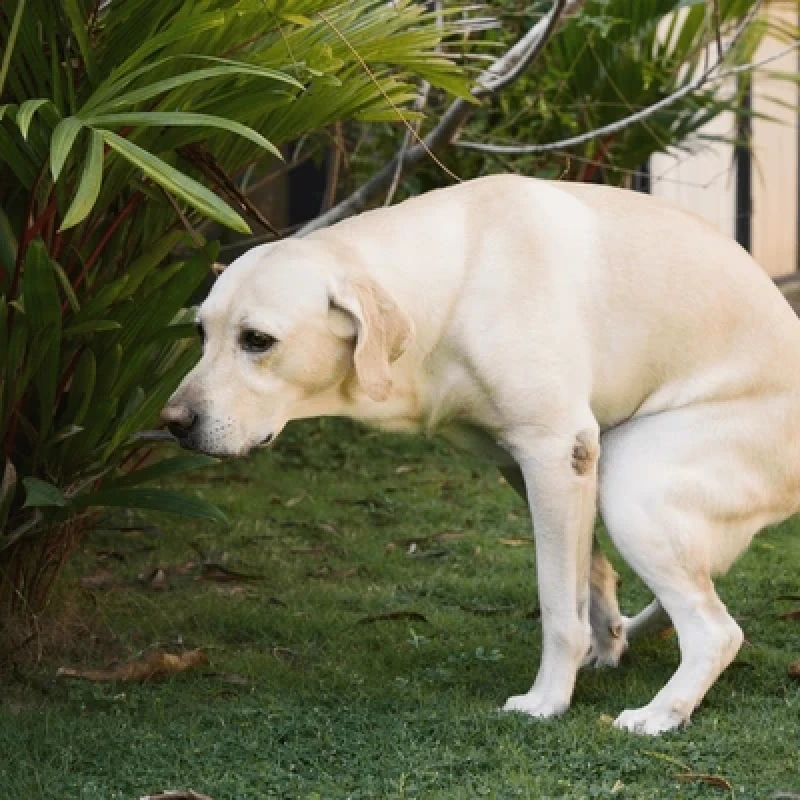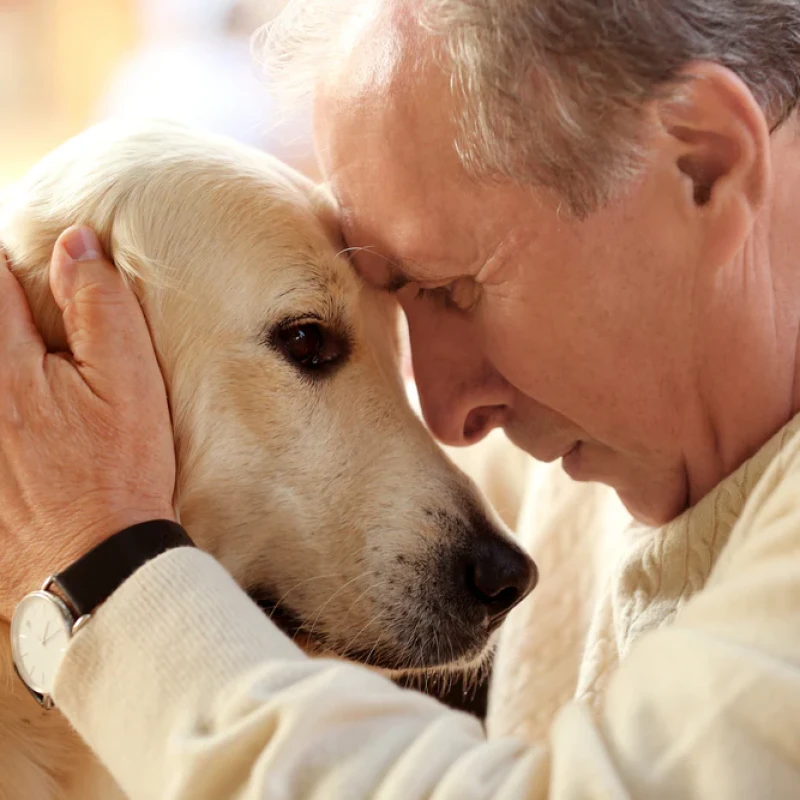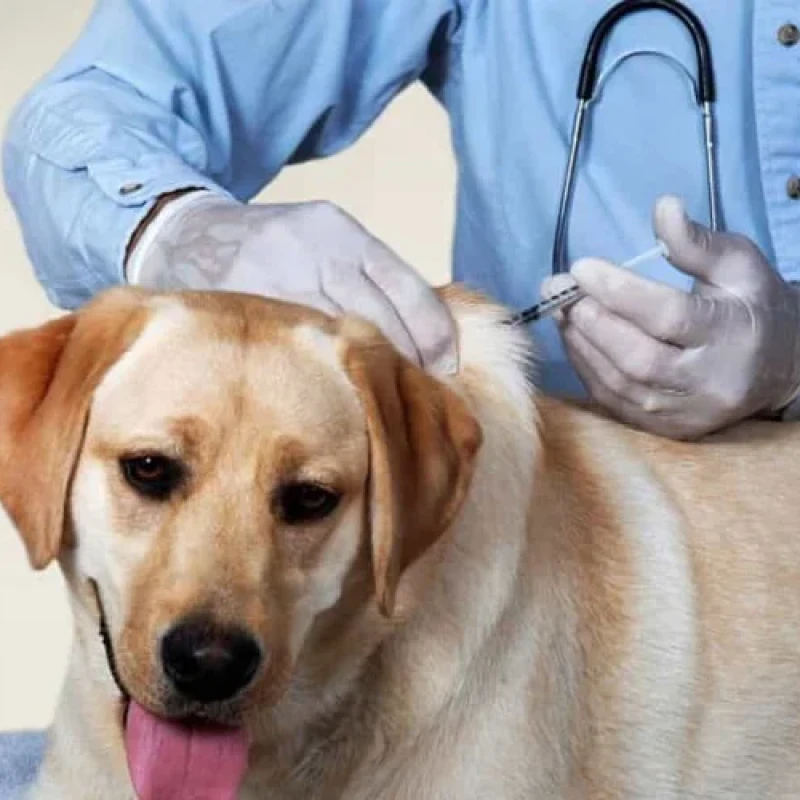Teaching your dog to toilet in the right place not only helps keep your home clean but also reflects your respect and understanding of your beloved pet. Starting this training as early as possible, especially with puppies, will help establish good habits and prevent hygiene issues later on. For adult dogs, this can be quite challenging due to ingrained habits. However, don't worry! In this article, Pet Mart will share simple yet highly effective tips for teaching your dog to toilet in the right place.
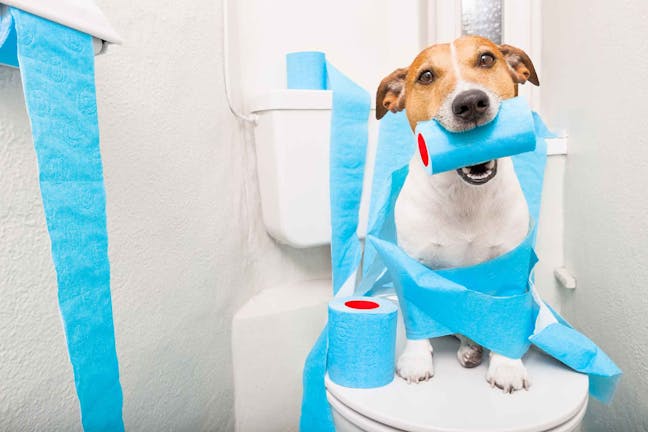
Reasons Why Dogs May Toilet in the Wrong Place
Have you ever wondered why your dog tends to "mess around" by toileting everywhere? Below is all the information you need to know about teaching your dog to toilet in the right place:
Psychological State: Unlike when a dog urinates or defecates due to excitement or when meeting a partner, inappropriate toileting usually stems from fear. Being beaten, mistreated, and other psychological stressors can be the main causes of this behavior.
Not a Conscious Decision: Dogs do not toilet at will, nor is it directed by their nervous system. This occurs completely "naturally and unconsciously."
High-Risk Breeds: Certain breeds, such as Toy Poodles, Corgis, Maltese, Yorkshire Terriers, Chihuahuas, Pomeranians, Shih Tzus, Golden Retrievers, Boston Terriers, Pugs, Pekingese, and Bulldogs, have a higher probability of losing control when toileting.
Health Issues: Some diseases can cause dogs to lose control when toileting, such as parasitic infections, parvovirus, infectious hepatitis, and many others. Additionally, spinal cord injuries, consciousness disorders, meningitis, tumors, and cancer can also be causes. This will make it more challenging to teach dogs to toilet in the right place.
Signs That Your Dog Wants to Toilet
- Right after waking up
- After eating or before mealtime
- When coming out of their crate or home
If a puppy needs to toilet, they will run around in circles, sniff, squat, or whine. You must take them outside immediately upon noticing these signs. If you catch the puppy about to toilet "in the wrong place," startle them. You might shout loudly, clap your hands, or hit the wall or table. Then take them outside to the designated spot and encourage them to relieve themselves there. If it’s too late and they’ve already gone inside, still take them outside. This is the minimum method for teaching your dog to toilet in the right place.
You must take the dog outside as soon as you see the above signs. If you don't pay attention to them for a while, they may have no choice but to go in their sleeping spot. You will have to spend time cleaning up and may even feel frustrated.
Tips for Teaching Your Dog to Toilet in the Right Place
For dog owners, teaching pets to toilet in the right place is always an important and sometimes complex issue. To create a clean and comfortable environment for both the dog and the owner, combining an understanding of the dog’s nature with training techniques is crucial. Let’s explore some tips and optimal timings to assist you in this process:
Understand Your Dog: First and foremost, understanding your dog's characteristics and personality will make training easier. Dogs naturally do not like to toilet where they usually lie or in their living areas. Depending on the breed and individual personality, training approaches may vary.
Timing is Key: Based on eating habits, you can easily predict when your dog needs to toilet. About 15-30 minutes after eating, take your dog to the place where you want them to toilet. Pay attention to signs like barking or wagging their tail to know when they want to go out.
Choose a Specific Toilet Area: Select a specific location and take your dog there each time they need to toilet. Over time, the dog will remember and go there automatically when they need to toilet.
Establish a Fixed Schedule: A regular feeding and toilet schedule will help the dog develop a habit and make it easier for you to manage.
Quick Response: Whenever you notice signs that your dog wants to toilet, take them outside immediately. This helps the dog associate the need to toilet with going outside.
Be Patient and Consistent: During the training process, maintain a patient attitude. Instead of punishing the dog when they make a mistake, praise and reward them whenever they toilet in the right place.
Teaching Your Dog to Toilet on Paper
Choose a Suitable Location: Select an area that is easy to clean, such as the kitchen or bathroom, to lay down paper. Avoid areas close to where the dog plays, eats, or rests, as dogs usually maintain hygiene in these zones.
Lay Down Paper and Observe: Spread several sheets of paper in the chosen area. Watch for signs from your dog: signs that they want to toilet include sniffing around, running in circles, and trying to find a suitable spot.
Guide and Praise: When you notice signs that they want to toilet, guide the dog to the paper area. After the dog has "done their business" on the paper, praise them.
Replace and Retain Scent: Remove the soiled paper and replace it with clean paper. Place the clean paper under the soiled one so the dog can easily sniff it next time.
Repeat the Process: Repeat this method of teaching your dog to toilet in the right place daily, as puppies can forget quickly.
Handle Incorrect Toileting: If the dog toilets in the wrong place, use a deodorizing spray to eliminate the scent. Place the soiled paper on top of the clean paper to help the dog remember where to toilet.
How to Train Your Dog Not to Go to the Bathroom in Their Crate
Make the Crate Comfortable: Place a few of your dog's favorite toys in the crate to help them feel comfortable and secure while inside.
Limit Time in the Crate: Do not leave your dog in the crate for too long, as they may not be able to control their urge to go. As soon as you notice that your dog needs to relieve itself, take them out of the crate as soon as possible.
Train Your Dog to Enter and Exit the Crate: Teach your dog how to exit the crate when necessary, and then train them to go back in on their own.
Establish a Routine: Create a regular schedule for taking your dog outside to relieve themselves. Once your dog becomes accustomed to this schedule, they will adjust their behavior and stop relieving themselves in the crate.
Differentiate Areas: Teach your dog to distinguish between their sleeping area, crate, and eating area. Ensure that your dog does not relieve themselves in these areas.
Check and Evaluate: If the training is successful, your dog will know to enter the crate when they need to sleep and go outside to relieve themselves when necessary. You may not need to close the crate door, as you can trust that your dog will not relieve themselves inside.
How to Train Your Dog to Relieve Themselves Outdoors
Prepare the Environment: Ensure that your front door is open or that there is a yard so your dog can easily go in and out.
Train Your Dog to Go Outside: Lead your dog out through a single path. Take them to a specific spot outside to relieve themselves, helping them become familiar with the location.
Observe and Reward Your Dog: Stand at a suitable distance, without disturbing your dog. When your dog has finished, praise and reward them.
Determine Timing for Taking Your Dog Out: Puppies typically need to relieve themselves about every 3-4 hours. Be sure to take them out after eating, after playing, and after waking up. Take your dog outside at least 3-4 times a day and before bed at night.
Monitor the Puppy: In the first few months of using this training method, you need to be present to supervise your puppy every time you take them outside.
Maintain General Cleanliness: After your dog relieves themselves, use a plastic bag to pick up the waste and tie it tightly. Dispose of the waste in the trash, rather than burying it, as it may contain parasites. Always remember to clean up after your dog to protect the environment and public health.
How to Train Your Dog to Use the Toilet
Understand Your Puppy’s Habits: Puppies often urinate frequently. Allow your dog to play and return them to the crate or designated area every 15 minutes. Dogs prefer to relieve themselves in grass or at tree bases, usually 1-5 minutes after eating.
Set a Schedule: Divide this training into 3-4 sessions each day: morning, afternoon, evening, and night.
Morning and Afternoon Training: Right after waking up and feeding your dog, take them to the bathroom. Use the command “Go pee” and praise your dog when they relieve themselves in the right place. Take your dog to the bathroom with you for about 1-2 minutes.
Afternoon Training: When you return home, first complete some personal tasks. Take your dog to the outdoor bathroom for about 5-10 minutes. When your dog relieves themselves in the grass or at the tree base, use the command “Go pee” and praise them. Always carry a plastic bag to pick up your dog’s waste.
Evening Training: Teach basic commands like “Wait” and “Go pee.” The command “Wait” helps your dog focus and obey commands from you. By learning commands daily, your dog will obey and avoid eating disorders.
End the Session: Each session should only last 5-10 minutes. Avoid rewarding your dog with treats during training.
Differences Between Training Puppies and Adult Dogs to Relieve Themselves Properly
When you own a dog, one of the most important tasks is teaching them to relieve themselves in the proper place. Whether it’s a puppy or an adult dog, this requires patience and consistency. However, training an adult dog differs from training a puppy due to certain distinct factors:
Urination and Defecation Timing – Puppies: Due to their small bodies and frequent urination, they need to go out after every meal, playtime, or waking up. Adult Dogs: They can hold it longer and do not need to go out as often as puppies.
Established Habits – Puppies: Being young and without established habits, puppies easily accept new lessons. Adult Dogs: For dogs with bad habits, changing their old habits takes more time and effort.
Patience and Repetition – Puppies: Require high levels of patience and repeated training to master commands. Adult Dogs: More easily grasp and quickly change if they have been trained before.
Response to Praise and Rewards – Puppies: Highly sensitive to praise and rewards. Adult Dogs: Depending on their past, they may be less responsive to praise or rewards compared to puppies.
Training Time – Puppies: Since they are young, training them requires more time and patience. Adult Dogs: With prior experience, adjusting their habits often happens more quickly.
Medical Issue Assessment: Only for adult dogs, a sudden change in their bathroom habits can indicate a health problem.
Differences Between Training Female and Male Dogs to Relieve Themselves Properly
Training male and female dogs to relieve themselves in the right place has some differences based on each gender's instincts and natural behavior. While both genders require patience and repetition during training, training male dogs may require different strategies compared to female dogs, especially due to their instinct to mark territory:
Territorial Marking Behavior – Male Dogs: Tend to mark their territory by urinating multiple times in various places rather than just once. This can complicate training. Female Dogs: Exhibit less territorial marking behavior than male dogs. However, when they are in heat, they may urinate more frequently.
Urination Timing – Male Dogs: Due to territorial marking behavior, male dogs may feel the need to urinate every time they go outside or when meeting other dogs. Female Dogs: Typically only urinate a few times each time they go outside.
Behavior When Urinating – Male Dogs: Often lift their leg when urinating to mark territory. Female Dogs: Typically squat when urinating.
Reproductive Cycle Issues – Female Dogs: When in heat, female dogs may exhibit increased urination and may have blood. Owners need to understand and prepare for this. Male Dogs: Do not have a reproductive cycle like females, but their behavior may change when a female dog in heat is nearby.
Training Time – Male Dogs: Due to their strong instinct to mark territory, training male dogs may take longer. Female Dogs: While they learn to relieve themselves properly more easily, training can become more complicated during their heat cycle.
Products to Support Toilet Training for Dogs
In teaching dogs to go to the toilet in the right place, the key is to combine patience and consistency in training with the proper use of support products. Below are some support products you can use to make training more effective:
- Puppy Pads: A convenient solution that quickly absorbs liquid and neutralizes odors. Especially useful for puppies or older dogs.
- Attractant Sprays: Products that help encourage dogs to go to the toilet where you want by using a special scent. They work quickly after 3-5 days of use.
- Odor Eliminating Spray: Removes unpleasant smells and prevents dogs from repeating bad habits.
- Dog Crates or Kennels: Helps dogs focus on going to the toilet in designated areas. Creates a sense of security for the dog and minimizes feelings of isolation.
- Toilet Training Toys: Toys that help keep dogs focused and encourage them to go to the toilet after playing.
- Dog Waste Bags and Hygiene Gloves: Maintain environmental hygiene and provide convenience when you and your dog go for a walk.
- Dog Toilet Trays: Provide a fixed place for dogs to go to the toilet, helping them adapt and comply more easily.
- Training Leashes: Assist you in taking the dog outside and supervising the dog during training.
Should You Punish Dogs for Not Going to the Toilet in the Right Place?
During the process of teaching dogs to go to the toilet in the right place, a question arises: should we use punishment or hit the dog when they don’t comply?
Misunderstanding Between Punishment and Hitting: The term "punishment" does not equate to "hitting." Hitting a dog can cause fear, urinary incontinence, and counterproductive results in training. “Punishment” here should be understood as “scolding,” “lightly grabbing the scruff,” or “quickly poking the armpit.”
Why You Shouldn’t Hit or Scold Dogs: Hitting or scolding dogs after they have gone to the toilet in the wrong place does not help them associate or learn. They will only learn to fear you and will continue to make mistakes when you are not there.
Proper Punishment: When a dog goes to the toilet incorrectly, scold them with "Bad toilet" and give a light tap on the rear. Take the dog to the correct toilet area and have them sit there for about 1-2 minutes. Do not close the door or confine the dog.
Necessary Training Skills: Learn and apply ways to teach dogs to go to the toilet in the right place using commands like "Go toilet," "Bad toilet," "Wait," along with the form of "punishment." Combining these methods helps dogs form the habit of going to the toilet in the right place.
Reminder: Do not punish dogs while they are in the process of toileting. Use dog urine odor eliminators to prevent them from returning to where they previously went.
The Importance of Praise: When dogs do it right, praise them immediately. Dogs forget quickly, so praise right after they perform correctly; don’t wait. You can use treats, sausages, or snacks like bones and other goodies as praise.
Throughout the process of teaching dogs to go to the toilet in the right place, patience and consistency are the most important. Punishment should not be the main method of training dogs; instead, focus on praising and rewarding correct actions. Good luck!

